Investigation of Hydraulic Fracturing Crack Propagation Behavior in Multi-Layered Coal Seams
Abstract
Featured Application
Abstract
1. Introduction
2. Analysis of Crack Initiation Pressure of Inclined Crossing Borehole Wall
2.1. Analysis of Stress Distribution in Inclined Borehole
2.2. Stress Distribution of Rock Surrounding Wall of Inclined Borehole
2.3. Analysis of Crack Initiation Pressure of Multi-Layered Coal
2.3.1. Analysis of Cracking Pressure When Cracking Occurs along Radial Direction of Borehole
2.3.2. Analysis of Cracking Pressure When Cracking Occurs along Axial Direction of Borehole
3. Hydraulic Fracturing Experiment
3.1. Experimental Apparatus
3.2. Experimental Design
3.3. Specimen Preparation
3.4. Experimental Procedure
3.5. Results and Analysis
3.5.1. Influence of Geo-Stress on Coal Seam Hydraulic Fracturing
3.5.2. Influence of Coal Seam Dip Angle on Hydraulic Fracturing
4. Three-Dimensional Numerical Simulation of Hydraulic Fracturing
4.1. Simulation Model and Parameters
4.2. Simulation Results and Analysis
- (1)
- The cracking location of the hydraulic fracturing in the multi-layered coal seam was always in the soft coal layer. When the depth was 300 m, the initiation pressure of the multi-layered coal seam was 12.6 MPa. When the depth reached 800 m, the initiation pressure was 27.5 MPa, which marks an increase of 2.2 times. Figure 11 shows the variation of the initiation pressure of the multi-layered coal seam under different depths and geo-stress states. As can be seen, the initiation pressure of the multi-layered coal seam linearly increased with the increase of the coal seam depth. As shown in Figure 11, the theoretical calculation results are in good agreement with the numerical simulation results.
- (2)
- The hydraulic fracturing cracks occurred along the X direction (minimum principal stress direction) in the soft coal layer, and propagated along the Z direction (maximum principal stress direction), without penetrating the hard coal layer. The direction of hydraulic fracture propagation in multi-layer coal seams is consistent with that of single coal seam. The half width of the fracture was approximately 0.02 m at different coal seam depths, when the water injection time was 20 s. When the water injection time reached 300 s, the half width of the fracture in the multi-layered coal seam with a simulated depth of 300 m was 0.033 m, and the half width of the fracture in the multi-layered coal seam with a simulated depth of 800 m was 0.063 m (Figure 12). As the burial depth and three-dimensional geo-stress increased, the width of the hydraulic fractures in the soft layer of the multi-layered coal seam significantly increased. The research results are similar with the rules shown in Reference [35].
5. Conclusions
Author Contributions
Funding
Acknowledgments
Conflicts of Interest
References
- Wang, H.F.; Cheng, Y.P.; Yuan, L. Gas outburst disasters and the mining technology of key protective seam in coal seam group in the Huainan coalfield. Nat. Hazards 2013, 67, 763–782. [Google Scholar] [CrossRef]
- Díaz Aguado, M.B.; González Nicieza, C. Control and prevention of gas outbursts in coal mines, Riosa-Olloniego coalfield, Spain (Article). Int. J. Coal Geol. 2007, 69, 253–266. [Google Scholar] [CrossRef]
- Lin, B.Q. Mine Gas Control Theory and Technology; China University of Mining and Technology Press: Xuzhou, China, 2010. [Google Scholar]
- Karacan, C.O.; Ruiz, F.A.; Cote, M.; Phipps, S. Coal mine methane: A review of capture and utilization practices with benefits to mining safety and to green-house gas reduction. Int. J. Coal Geol. 2011, 86, 121–156. [Google Scholar] [CrossRef]
- Xia, T.; Zhou, F.; Liu, J.; Gao, F. Evaluation of the pre-drained coal seam gas quality. Fuel 2014, 130, 296–305. [Google Scholar] [CrossRef]
- Bredehoeft, J.; Wolff, R.; Keys, W.; Shuter, E. Hydraulic fracturing to determine the regional in situ stress field, piceance basin, colorado. Geol. Soc. Am. Bull. 1976, 87, 250–258. [Google Scholar] [CrossRef]
- Abou-Sayed, A.; Brechtel, C.; Clifton, R. In situ stress determination by hydrofracturing: A fracture mechanics approach. J. Geophys. Res. Part B Solid Earth 1978, 83, 2851–2862. [Google Scholar] [CrossRef]
- Fan, T.; Zhang, G.; Cui, J. The impact of cleats on hydraulic fracture initiation and propagation in coal seams. Pet. Sci. 2014, 11, 532–539. [Google Scholar] [CrossRef]
- Hubbert, M.K.; Willis, D.G. Mechanics of hydraulic fracturing. Dev. Pet. Sci. 1972, 210, 369–390. [Google Scholar]
- Dunlap, I.R. Factors controlling the orientation and direction of hydraulic fractures. Soc. Pet. Eng. 1962, 49, 282–288. [Google Scholar]
- Zhang, G.H.; Wei, G.P.; Hou, F.C. The theory of water injection pressure and cracking position of fractured layer drilling. J. Coal 2007, 32, 52–55. [Google Scholar]
- Lu, Y.C. Application of hydraulic fracturing technology in high gas and low permeability mines. J. Chongqing Univ. 2010, 33, 102–107. [Google Scholar]
- Schmitt, D.; Zoback, M. Poroelastic effects in the determination of the maximum horizontal principal stress in hydraulic fracturing tests—A proposed breakdown equation employing a modified effective stress relation for tensile failure. Int. J. Rock Mech. Min. Sci. Geomech. 1989, 26, 499–506. [Google Scholar] [CrossRef]
- Schmitt, D.R.; Currie, C.A.; Zhang, L. Crustal stress determination from boreholes and rock cores:Fundamental principles. Tectonophysics 2012, 580, 1–26. [Google Scholar] [CrossRef]
- Bohloli, B.; de Pater, C.J. Experimental study on hydraulic fracturing of soft rocks: Influence of fluid rheology and confining stress. J. Pet. Sci. Eng. 2006, 53, 1–12. [Google Scholar] [CrossRef]
- Holditch, S.A. Enhanced recovery of Coalbed Methane through hydraulic fracturing. In Proceedings of the SPE Annual Technical Conference and Exhibition, Houston, TX, USA, 2–5 October 1988; pp. 1–9. [Google Scholar]
- Zhou, J.; Chen, M.; Jin, Y.; Zhang, G.Q. Analysis of fracture propagation behavior and fracture geometry using a tri-axial fracturing system in naturally fractured reservoirs. Int. J. Rock Mech. Min. Sci. 2008, 45, 1143–1152. [Google Scholar] [CrossRef]
- Chang, H. Hydraulic Fracturing in Particulate Materials. Ph.D. Thesis, Georgia Institute of Technology, Atlanta, GA, USA, 2004. [Google Scholar]
- Jiang, T.; Zhang, J.; Wu, H. Experimental and numerical study on hydraulic fracture propagation in coalbed methane reservoir. J. Nat. Gas Sci. Eng. 2016, 35, 455–467. [Google Scholar] [CrossRef]
- Wang, Y.; Tonon, F. Modeling Lac du Bonnet granite using a discrete element model. Int. J. Rock Mech. Min. Sci. 2009, 46, 1124–1135. [Google Scholar] [CrossRef]
- Barati, R.; Liang, J.T. A review of fracturing fluid systems used for hydraulic fracturing of oil and gas wells. J. Appl. Polym. Sci. 2014, 131, 40735. [Google Scholar] [CrossRef]
- Wang, T.; Hu, W.; Elsworth, D.; Zhou, W.; Zhou, W.; Zhao, X.; Zhao, L. The effect of natural fractures on hydraulic fracturing propagation in coal seams. J. Pet. Sci. Eng. 2017, 150, 180–190. [Google Scholar] [CrossRef]
- Zhang, X.; Jeffrey, R.G.; Bunger, A.P. Initiation and growth of a hydraulic fracture from a circular wellbore. Int. J. Rock Mech. Min. Sci. 2011, 48, 984–995. [Google Scholar] [CrossRef]
- Huang, J.S.; Griffiths, D.V.; Wong, S.W. Insitu stress determination from inversion of hydraulic fracture data. Int. J. Rock Mech. Min. Sci. 2011, 48, 476–481. [Google Scholar] [CrossRef]
- Huang, J.S.; Griffiths, D.V.; Wong, S.W. Initiation pressure, location and orientation of hydraulic fracture. Int. J. Rock Mech. Min. Sci. 2012, 49, 59–67. [Google Scholar] [CrossRef]
- Zhang, G.H.; Wei, G.P.; Hou, F.C. Theory of start-split affusion stress and start-split location about through coal delam inaions’ bore of hydraulic fracture. J. China Coal Soc. 2007, 32, 52–55. [Google Scholar]
- Deng, G.Z.; Huang, B.X.; Wang, G.D. Theoretical analysis of pressure parameters for water pressure expansion of circular hole wall cracks. J. Xi’an Inst. Sci. Technol. 2003, 23, 361–364. [Google Scholar]
- Defuel, L.; Clark, J. Hydraulic fracture propagation in layered rock: Experimental studies of fracture containment. Int. J. Rock Mech. Min. Sci. Geomech. Abstr. 1981, 24, 19–32. [Google Scholar]
- Crosby, D.G.; Rahman, M.M.; Rahman, M.K. Single and multiple transverse fracture initiation from horizontal wells. J. Pet. Sci. Eng. 2002, 35, 191–204. [Google Scholar] [CrossRef]
- Shimizu, H. Distinct Element Modeling for Fundamental Rock Fracturing and Application to Hydraulic Fracturing. Ph.D. Thesis, Kyoto University, Kyoto, Japan, 2010. [Google Scholar]
- Chen, M.; Zhang, G.Q. Petroleum Engineering Rock Mechanics; Science Press: Beijing, China, 2008. [Google Scholar]
- Jin, Y.; Chen, M.; Zhang, X.D. Hydraulic fracturing initiation pressure models for directional wells in naturally fractured formation. J. Pet. 2006, 27, 124–126. [Google Scholar]
- Zhang, G.H.; Liang, B.; Sun, G.Y. Analysis of the initial crack location and development process of coal seam along the borehole. J. China Coal Soc. 2005, 30, 34–37. [Google Scholar]
- Li, D.Q.; Zhang, S.C.; Zhang, S.A. Experimental and numerical simulation study on fracturing through interlayer to coal seam. J. Nat. Gas Sci. Eng. 2014, 21, 386–396. [Google Scholar] [CrossRef]
- Zhang, G.M.; Liu, H.; Zhang, J. Three-dimensional finite element simulation and parametric study for horizontal well hydraulic fracture. J. Pet. Sci. Eng. 2010, 72, 310–317. [Google Scholar] [CrossRef]
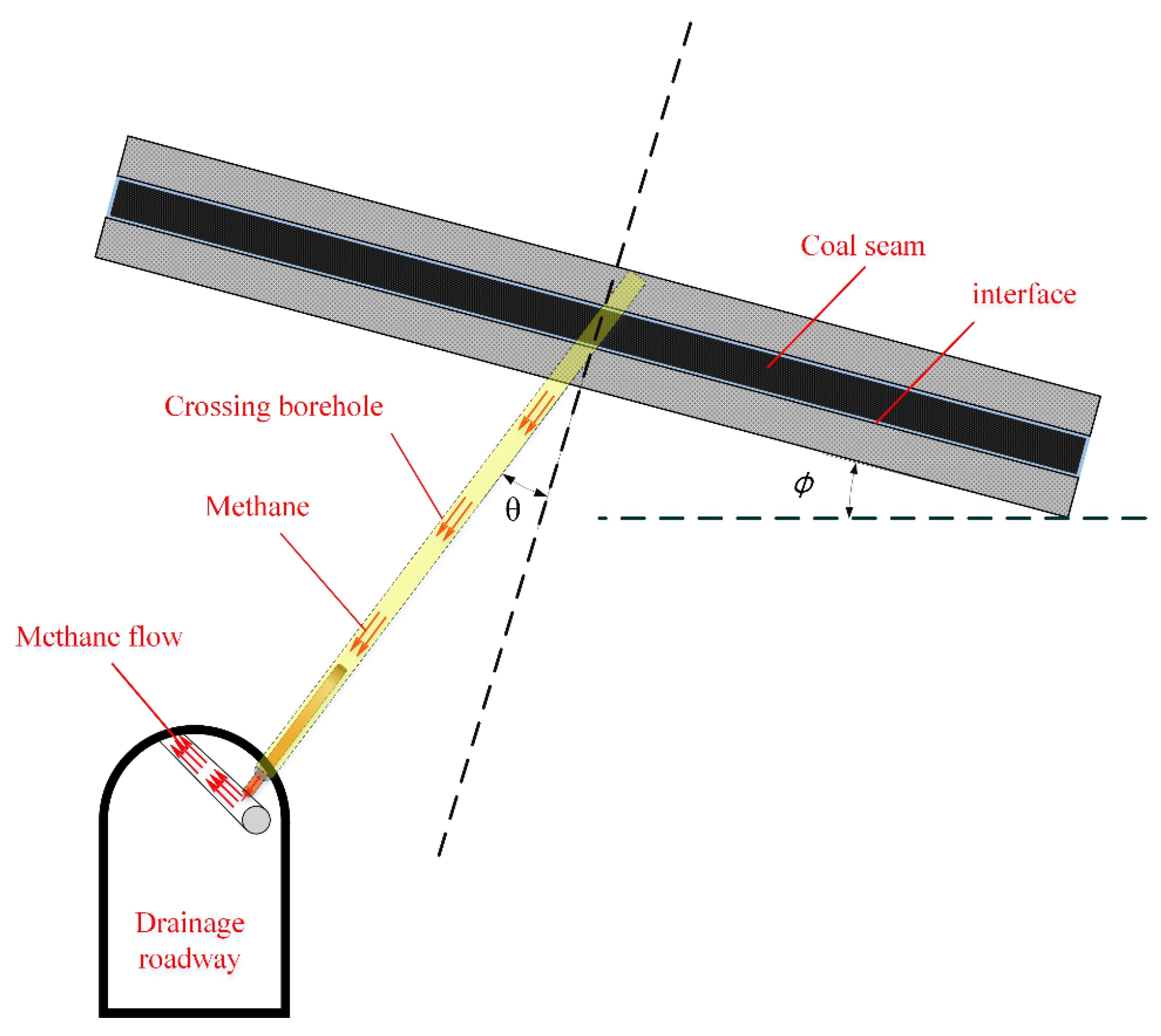
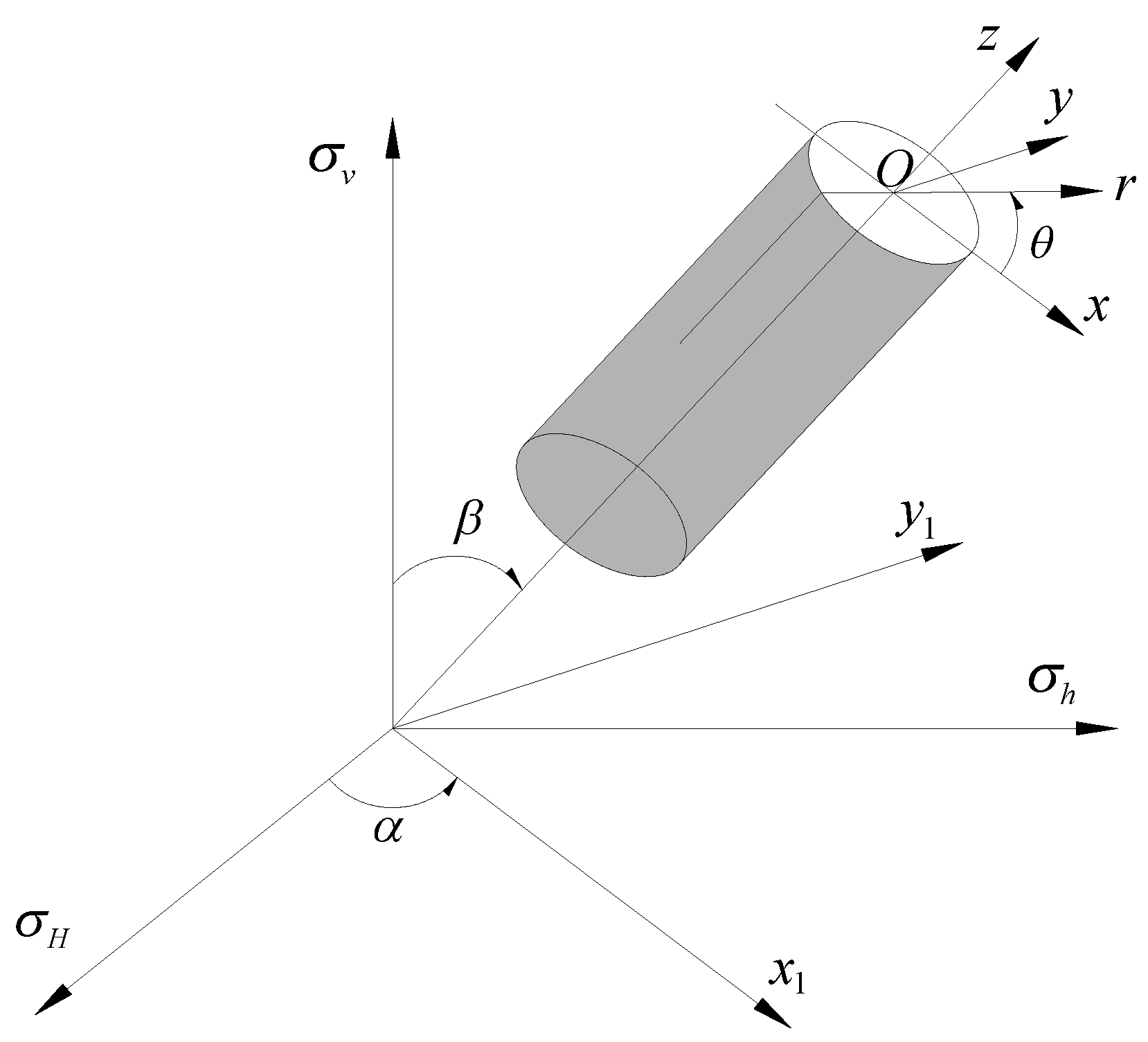
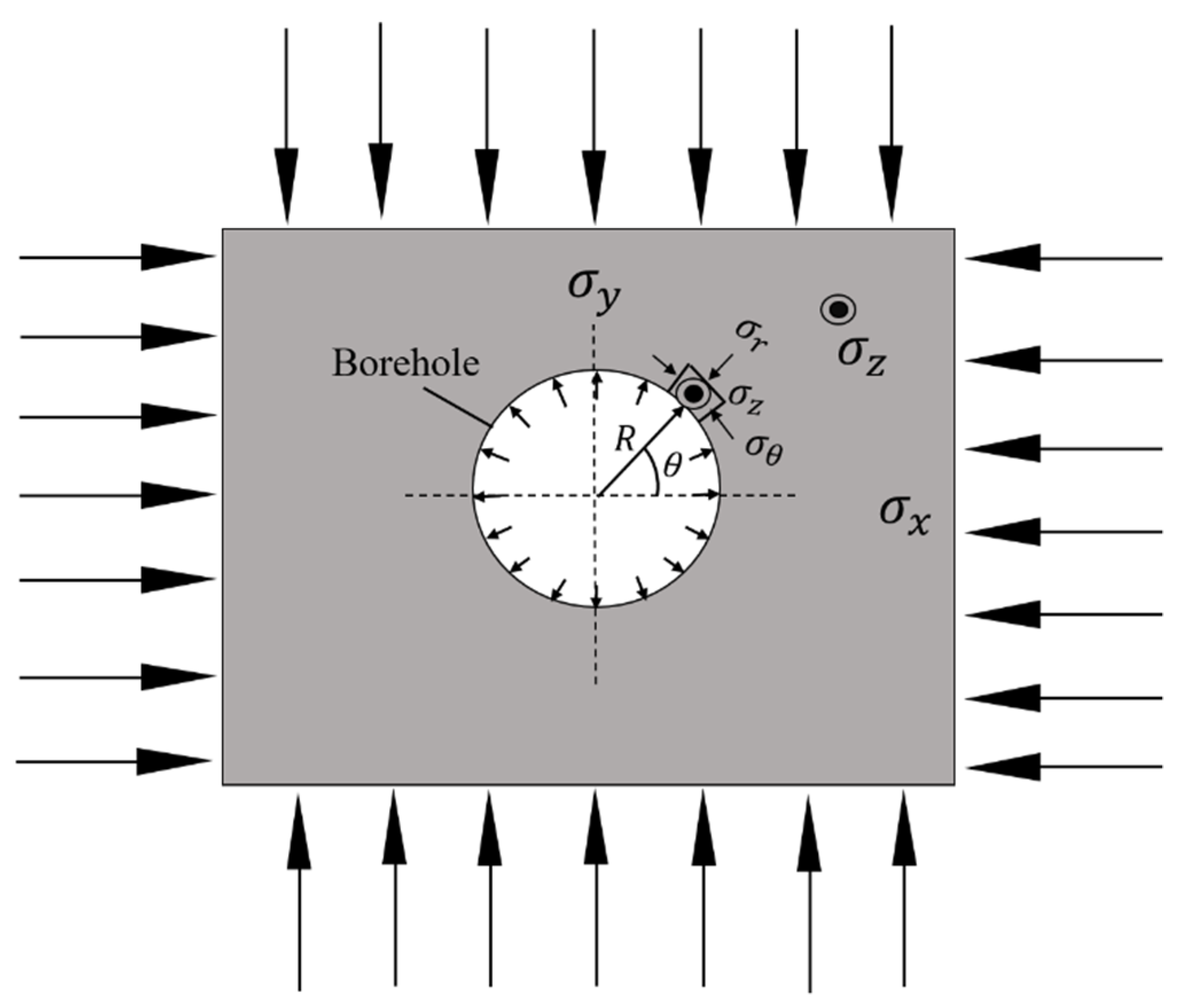
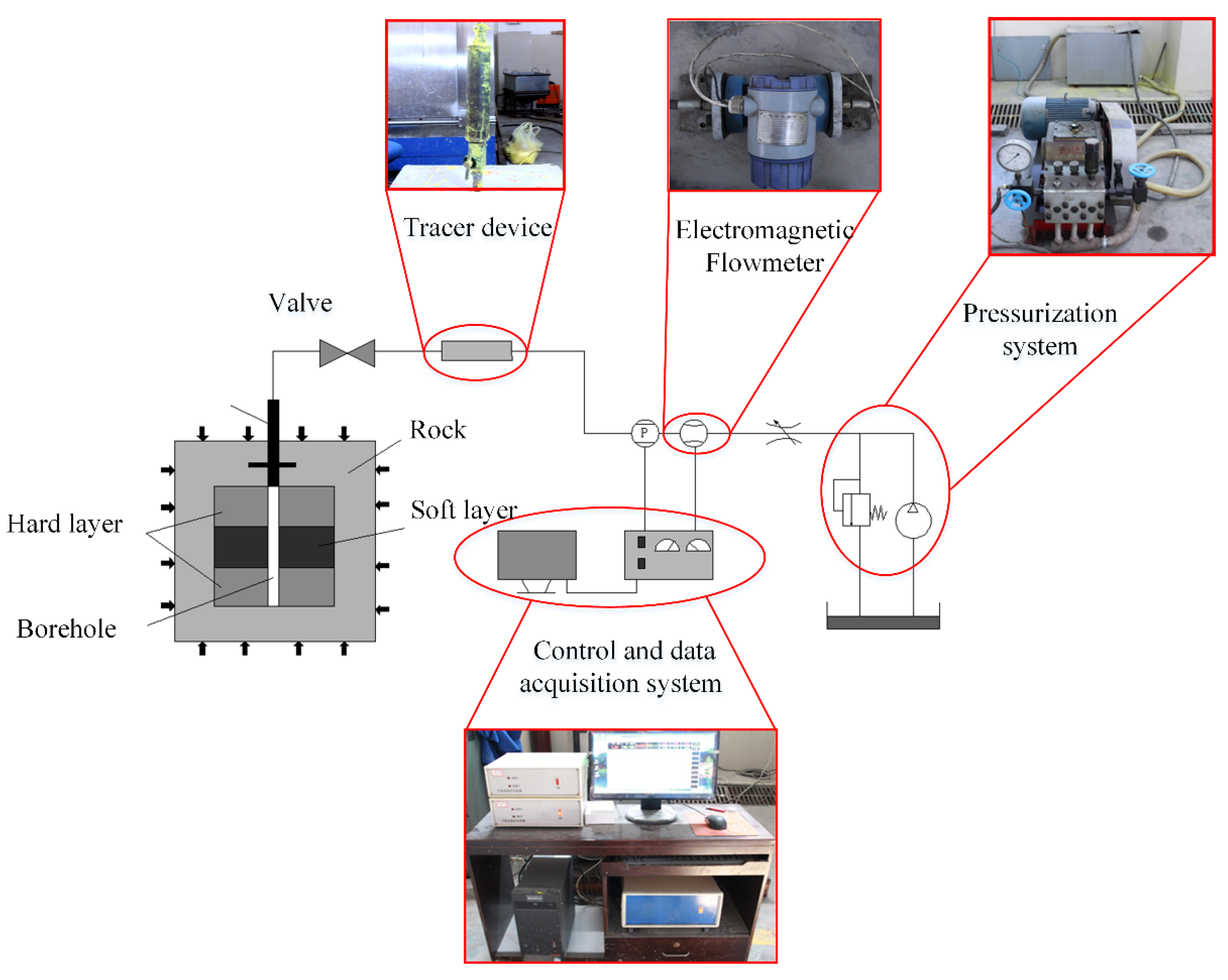
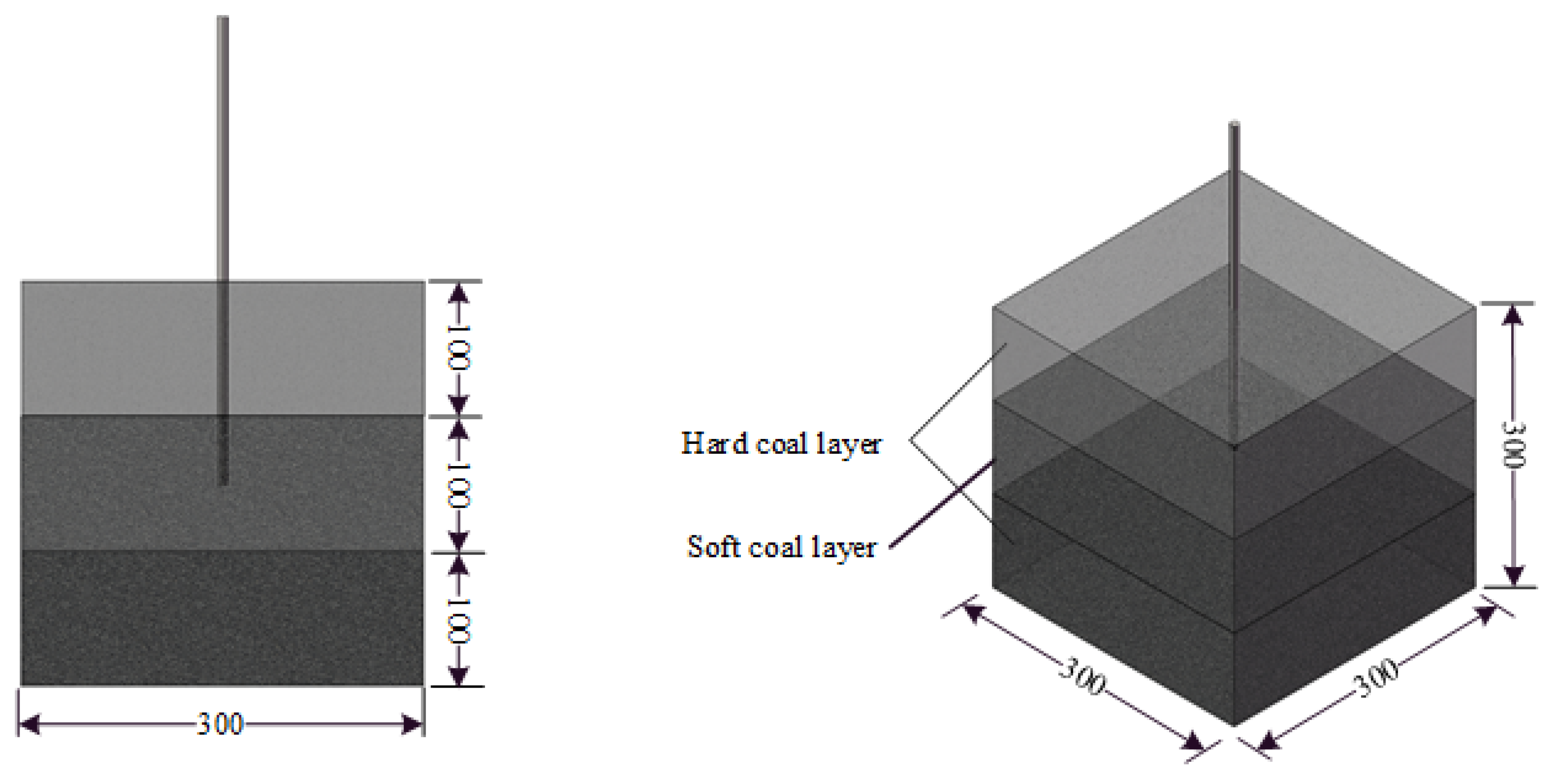

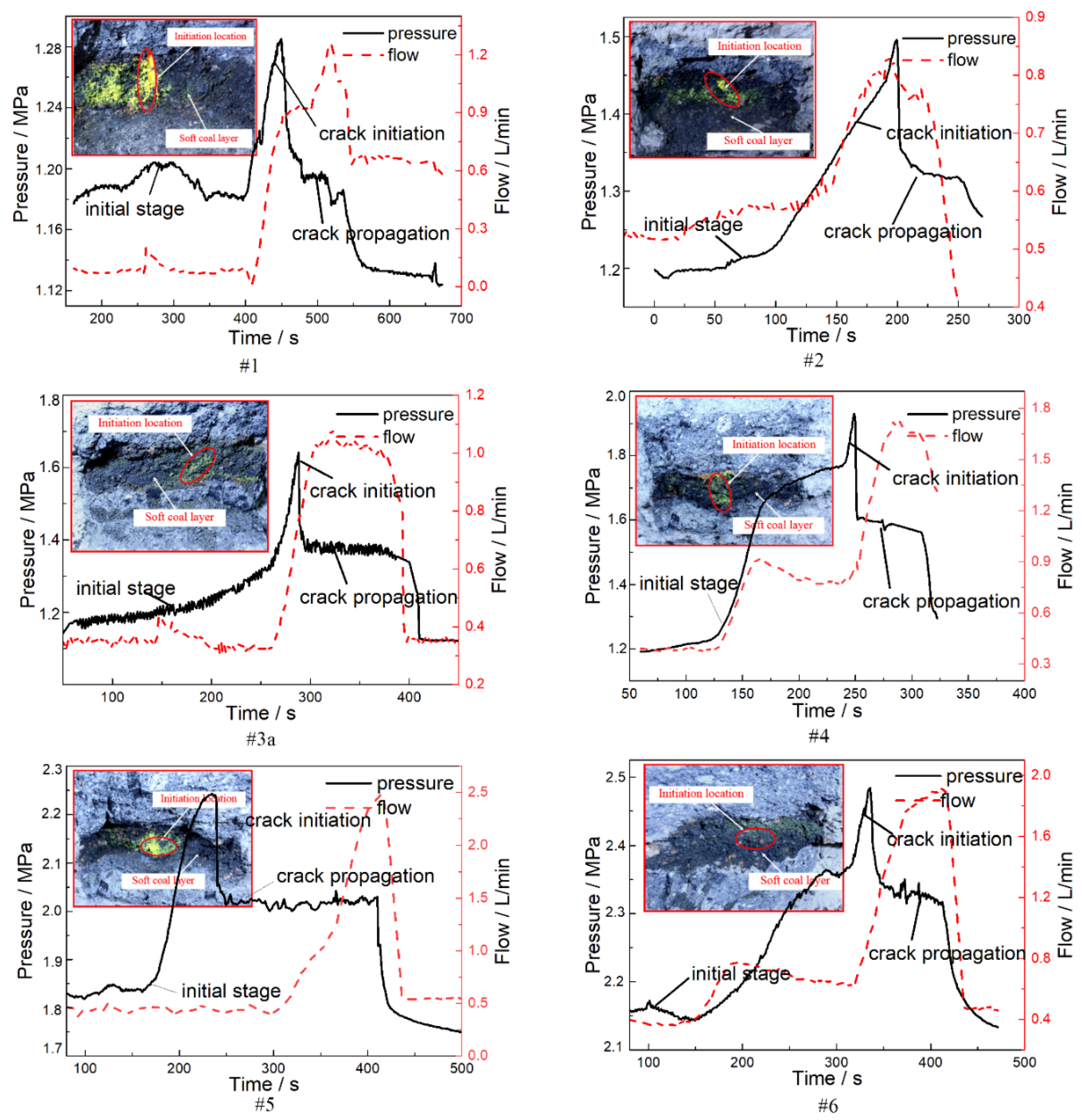
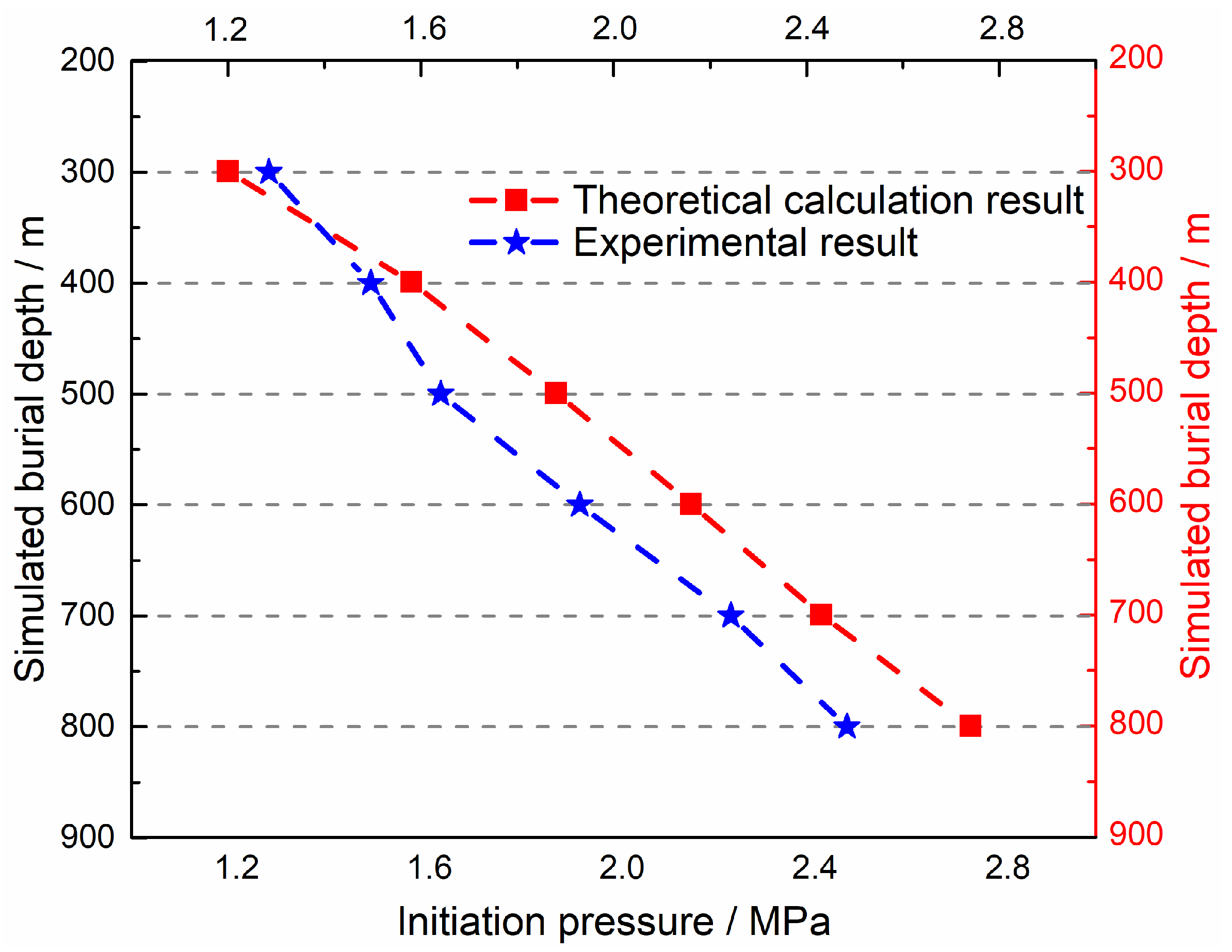
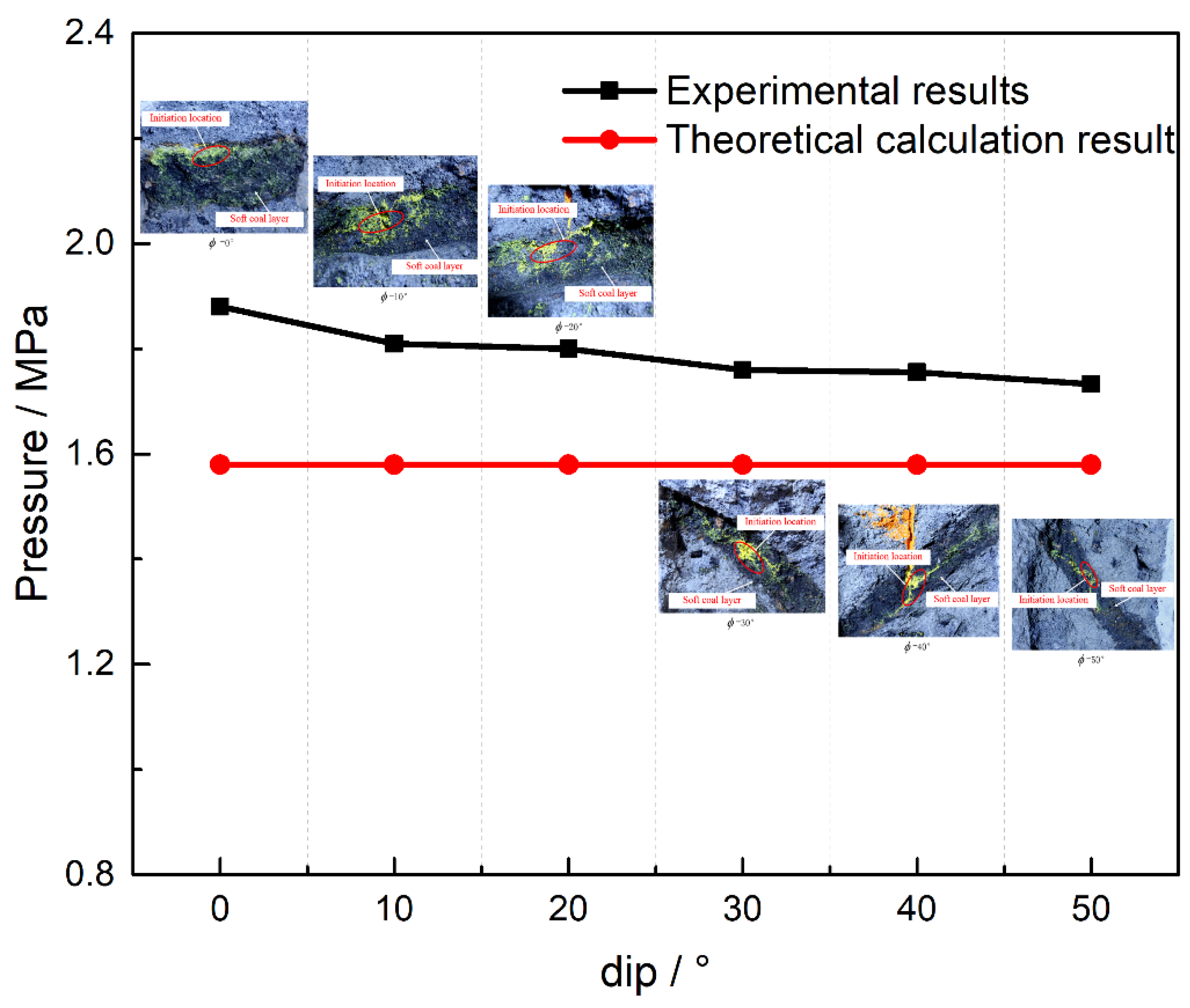
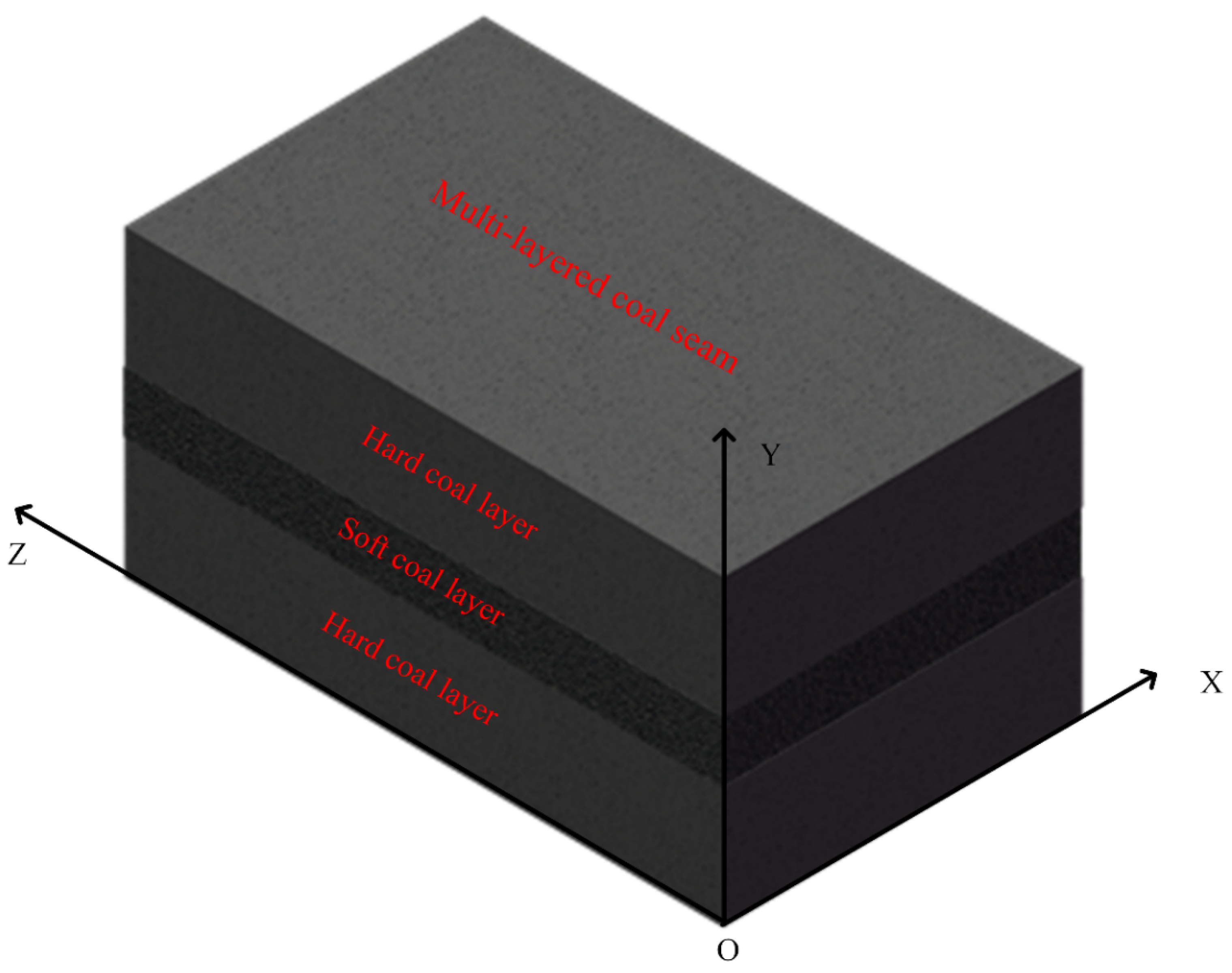
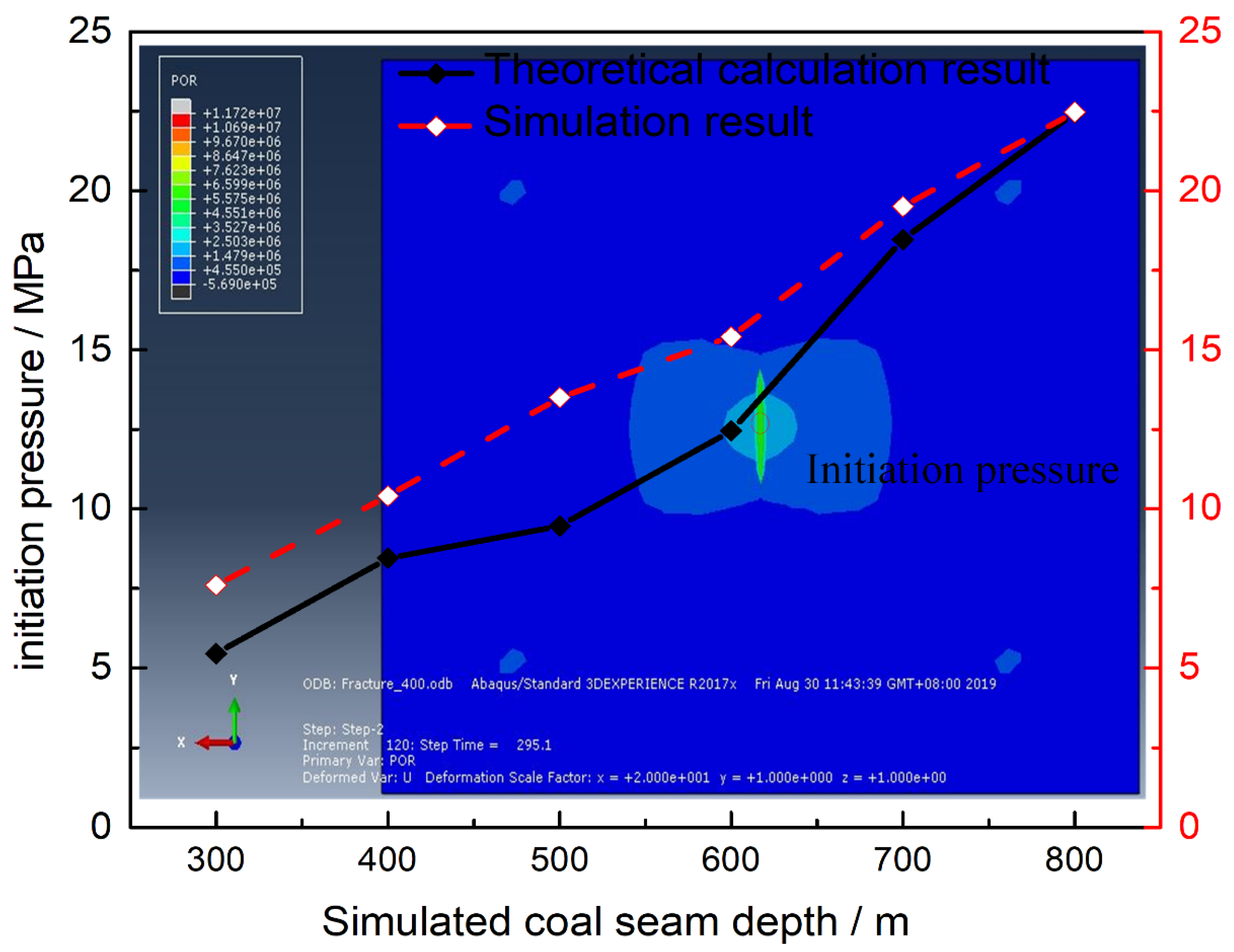
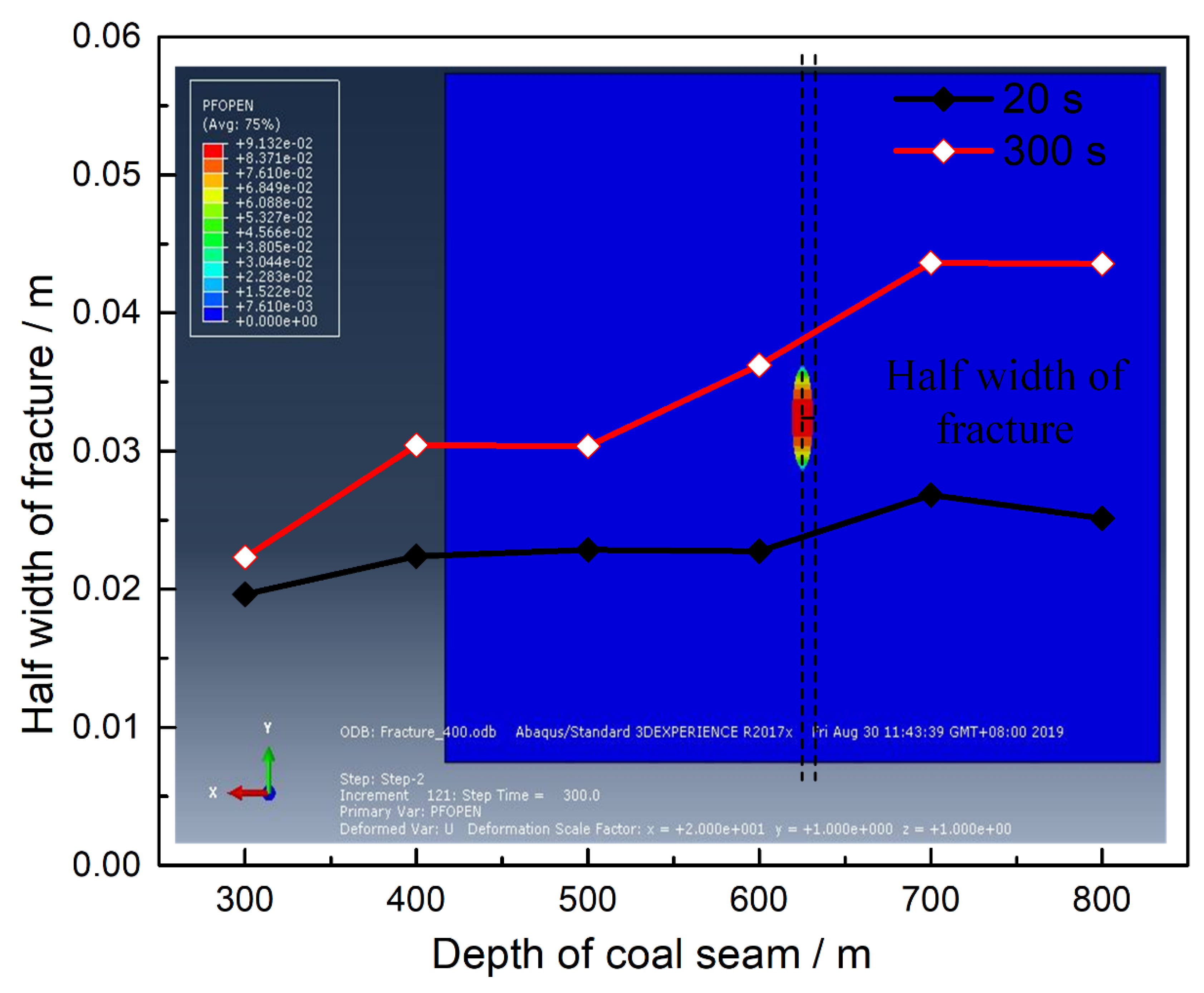
| Material Name | Quality Ratio | γ /kN/m−3 | /MPa | /MPa |
|---|---|---|---|---|
| Hard layer of coal seam | Pulverized coal:cement:gypsum = 3:3:1 | 1.9 | 7.01 | 0.66 |
| Soft layer of coal seam | Pulverized coal:soil = 3:1 | 1.3 | 3.67 | 0.45 |
| Number | Simulation Depth | /MPa | Coal Seam Dip/° | Fracturing Fluid |
|---|---|---|---|---|
| #1 | 300 | 1.07/1.07/0.64 | 0 | Water |
| #2 | 400 | 1.42/1.42/0.85 | 0 | Water |
| #3a | 500 | 1.78/1.78/1.07 | 0 | Water |
| #3b | 500 | 1.78/1.78/1.07 | 10 | Water |
| #3c | 500 | 1.78/1.78/1.07 | 20 | Water |
| #3d | 500 | 1.78/1.78/1.07 | 30 | Water |
| #3e | 500 | 1.78/1.78/1.07 | 40 | Water |
| #3f | 500 | 1.78/1.78/1.07 | 50 | Water |
| #4 | 600 | 2.13/2.13/1.28 | 0 | Water |
| #5 | 700 | 2.49/2.49/1.49 | 0 | Water |
| #6 | 800 | 2.84/2.84/1.71 | 0 | Water |
| Items | Unit | Hard Coal Layer | Soft Coal Layer |
|---|---|---|---|
| Elastic modulus | GPa | 2.2 | 0.4 |
| Poisson’s ratio | 0.39 | 0.15 | |
| Geo-stress σ x/σ y/σ z(300 m) | MPa | 5/8/10 | 5/8/10 |
| Geo-stress σ x/σ y/σ z(400 m) | 7/11/13 | 7/11/13 | |
| Geo-stress σ x/σ y/σ z(500 m) | 8/13/15 | 8/13/15 | |
| Geo-stress σ x/σ y/σ z(600 m) | 10/16/18 | 10/16/18 | |
| Geo-stress σ x/σ y/σ z(700 m) | 13/19/21 | 13/19/21 | |
| Geo-stress σ x/σ y/σ z(800 m) | 15/21/23 | 15/21/23 | |
| Permeability coefficient | m/s | 1 × 10−7 | 1 × 10−7 |
| Fluid leak off | 1 × 10−14 | 1 × 10−14 | |
| Pore ratio | 0.2 | 0.2 | |
| Fluid gravity | N/m3 | 9800 | 9800 |
| Saturation | 1.0 | 1.0 | |
| 2D flow | m2/s | 0.01 | 0.01 |
| Liquid viscosity | Pas | 0.001 | 0.001 |
© 2020 by the authors. Licensee MDPI, Basel, Switzerland. This article is an open access article distributed under the terms and conditions of the Creative Commons Attribution (CC BY) license (http://creativecommons.org/licenses/by/4.0/).
Share and Cite
Cao, S.; Li, X.; Zhou, Z.; Wang, Y.; Ding, H. Investigation of Hydraulic Fracturing Crack Propagation Behavior in Multi-Layered Coal Seams. Appl. Sci. 2020, 10, 1153. https://doi.org/10.3390/app10031153
Cao S, Li X, Zhou Z, Wang Y, Ding H. Investigation of Hydraulic Fracturing Crack Propagation Behavior in Multi-Layered Coal Seams. Applied Sciences. 2020; 10(3):1153. https://doi.org/10.3390/app10031153
Chicago/Turabian StyleCao, Shirong, Xiyuan Li, Zhe Zhou, Yingwei Wang, and Hong Ding. 2020. "Investigation of Hydraulic Fracturing Crack Propagation Behavior in Multi-Layered Coal Seams" Applied Sciences 10, no. 3: 1153. https://doi.org/10.3390/app10031153
APA StyleCao, S., Li, X., Zhou, Z., Wang, Y., & Ding, H. (2020). Investigation of Hydraulic Fracturing Crack Propagation Behavior in Multi-Layered Coal Seams. Applied Sciences, 10(3), 1153. https://doi.org/10.3390/app10031153





